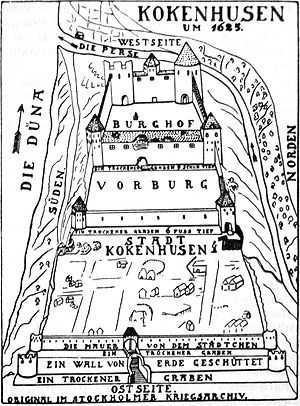Storm of Kokenhusen
| Storm of Kokenhusen | |||||||
|---|---|---|---|---|---|---|---|
| Part of Second Northern War / Russo-Swedish War (1656–1658) | |||||||
 A drawing of Kokenhusen and its fortress about 30 years prior to the storming. | |||||||
| |||||||
| Belligerents | |||||||
| Swedish Empire | Tsardom of Russia | ||||||
| Commanders and leaders | |||||||
| Tsar Aleksey Mikhailovich | |||||||
| Strength | |||||||
| 2500[1] | |||||||
| Casualties and losses | |||||||
|
67 killed 430 wounded[2] | |||||||
| ||||||
| ||||||||||||||||||||||
The Storm of Kokenhusen by the Russian Army under Tsar Alexei Mikhailovich was one of the first events of the Russo-Swedish War (1656–1658), a theater of the Second Northern War. On August 14, 1656, Russian troops stormed and captured the well-fortified town of Kokenhusen (Koknese) in Swedish Livonia (present-day Latvia)
According to the Tsar, this town “was very strong, had a deep moat, like a small brother of the Kremlin's moat, and its fortress is like a son of Smolensk's fortress”.
After capturing Kokenhusen, Russia gained control of the Daugava River and the way to Riga was opened.
References
- ↑ Акты Московского государства, изданные Императорской Академией Наук. Под ред. Попова Н.А. Том II. Разрядный приказ. Московский стол. 1635-1659. СПб, 1894. С.532
- ↑ Соловьёв С.М. Продолжение царствования Алексея Михайловича // История России с древнейших времен.